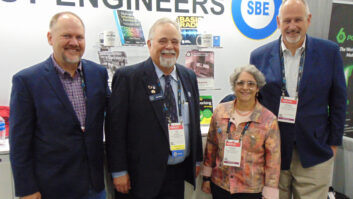Logical segmentation. Ethernet. Network topologies. Latency.
These are a few of the topics experts will discuss during the NAB/Ennes “Broadcast Networking Workshop: Putting the Pieces Together” on Saturday, April 21, at the Las Vegas Convention Center. The six-hour session is part of the Broadcast Engineering Conference at NAB2001. The conference is co-produced by NAB and SBE.
Computer networking technologies have made it necessary for broadcast engineers to broaden their professional skills. Engineers today are expected to understand things like system standards and media-based network platforms.
Modern demands
Moderated by Richard Farquhar, vice president of RAF Associates Inc., the tutorial will focus on information technology, network installation, network hardware support, hardware requirements and connectivity.
“A lot is asked of engineers now. The point of the Ennes workshop is to provide current technology information to broadcast engineers so that they can go back to their facility with the ability to fluently discuss networking issues,” Farquhar said.
“The profession has to embrace the technological advances to make the most of the opportunities.”
A quick scan of help-wanted ads in publications like RW shows the need for broadcast engineers to master this evolving technology. Today, ads for openings with major broadcasters may ask for broadcast engineers experienced in networks, client server architecture and network protocols.
Farquhar said the broadcast industry has reached the point where everything has to be tied together. The challenge becomes interfacing information technology with the traditional audio and video platform.
“You have to understand how different systems communicate. It’s all about transfer. Business and media systems have to understand the same protocol that allows for that communication,” he said.
Networking protocol refers to a set of rules that govern communications. One of the biggest challenges with media-based networks is conversion, Farquhar said.
Engineers will learn about two basic categories of networks: Local-Area and Wide-Area Networks, or LANs and WANs. A subset is computer network types, like Ethernet, ARCnet and Token Ring, said presenter Terry Baun, president of Criterion Broadcast Services and certification committee chair for the Society of Broadcast Engineers.
Ethernet, Token Ring and the Linux-based ARCnet are local-area technologies. WANs are simply interconnected local networks, Baun said.
More training needed
Baun said the SBE has discovered that most traditional broadcast engineers need further training on information technology.
“That’s simply because engineers were not trained in that specialty. It has become absolutely essential that they have some familiarity with basic networking issues.”
“Engineers should be in the loop on the decision-making process along with a MIS person when it comes to networking. Then they should be able to do some maintenance and troubleshooting after it’s installed,” Baun said.
The session’s focus will be on network hardware, Baun said, beginning with the basics. “We start out with the OSI (Open Systems Interconnection) network model and the different layers involved in building a network,” he said.
OSI consists of seven layers across which data must travel to get from one computer to another computer. The layers are split into two sets: the Application set and the Transport set.
Common computer network components like hubs, switches and bridges will be covered, Baun said. “We talk about cabling, connectors and doing a proper install. Things like coax, Cat-5 twisted pair and fiber optics.”
Issues specific to media-based systems will also be addressed, Baun said. “Things like sizing your UPS (uninterruptible power supply), grounding and surge suppression, and the advantages and disadvantages of the various kinds.”
Also to be explained: Audio Engineering Society/European Broadcast Union digital audio standard protocol. AES/EBU is the most common method for transmitting digital audio around a broadcast plant, Baun said.
Baun said the reliance of the broadcast industry on computers means engineers must learn about redundancy and how to back up systems when hard drives fail.
“With media platforms it’s so critical to have the support there because we have become so dependent on the PC to run the radio or television station. A computer crash or a network going down is no longer an option,” he said.
The broadcast engineering profession has gone through “basic break points” before, Baun said. This is when engineers need to develop new skills.
“For example, from tubes to transistors and from analog logic to integrated circuits and digital logic. This move into information technology is really no different. Engineers move ahead and learn,” he said.
Networking software will not be discussed at the session. The intent of the workshop is not to replace Novell- or Microsoft-specific courses, Farquhar said. Instead the goal is to put engineers in a position to learn basic network hardware issues “so that engineers can discuss network projects and serve as a resource to station management.”
Anyone attending the Broadcast Networking Workshop can take the SBE Certified Broadcast Networking Technologist (CBNT) exam upon the completion of the workshop. Contact SBE to register for the examination.











